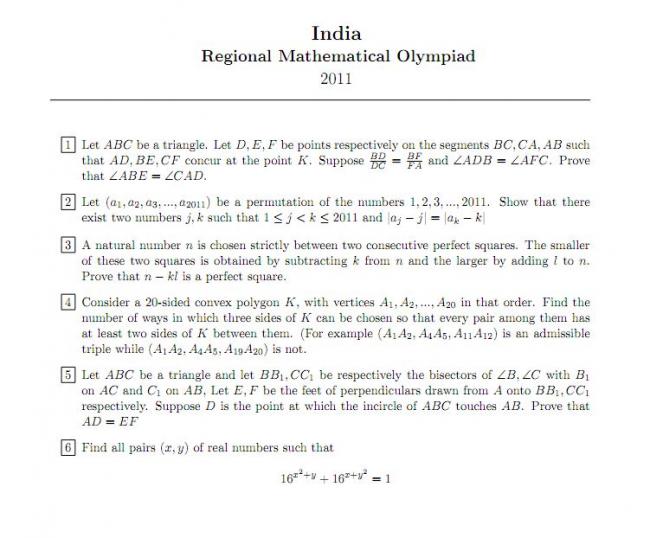Solution to problem 1:
We have \frac{BD}{DC} = \frac{BF}{FA} \implies \frac{AB}{BF}= \frac{BC}{BD} So FD \parallel AC.
\angle AFK = \angle KDB, so points F,K,D,B are cyclic. so \angle ABE = \angle FAD = \angle CAD , as desired.
Here are the problems of RMO 2011

Source: Mathlinks. ro
Solution to problem 1:
We have \frac{BD}{DC} = \frac{BF}{FA} \implies \frac{AB}{BF}= \frac{BC}{BD} So FD \parallel AC.
\angle AFK = \angle KDB, so points F,K,D,B are cyclic. so \angle ABE = \angle FAD = \angle CAD , as desired.
Solution to problem 2:
Assume on the contrary that b_i = |a_i-i| is distinct for all i .Note that 0\le b_i \le 2010.
We have b_i^2 = a_i^2+i^2 - 2 a_i i.
Summing up \sum_{i=1}^{2011}b_i^2 = \sum_{i=1}^{2011}(a_i^2+i^2) - 2 \sum_{r=1}^{2011}a_i i
so \sum_{r=0}^{2010}r^2 = 2\left ( \sum_{i=1}^{2011}\left ( i^2 - a_i i \right ) \right )
That's a contradiction since the r.h.s is even, but the l.h.s is odd. qed.
Solution to problem 3 :
Let n = p^2 + c, \; \; 1\le c \le 2p
From the first condition c= k. So n= p^2 + k.
From the second condition k + l = 2p+1,
So we have 4n- 4k = k^2 + l^2 + 2kl - 2k - 2l \iff 4(n-kl) = (k-l+1)^2. QED
4)
We first count number of non admissible triplets. If any two sides are consecutive call them connected , and if they have one side between them call them close. Count all triplets that have at least one pair of connected or closed sides.
case 1: connected:
When all three are connected. 20 triplets.
When only two pairs are connected, 20 ways to choose that pair, and 16 ways to select the the other. Total 20\times 16 ways.
case 2: close:
When two pairs are connected. total 20 ways.
when only one pairs are connected 20 ways to choose the connected pair and 13 ways to select the other, which is not connected with any of other sides.
And all three pairs can not be connected for a 20 sided polygon.
On addition total 620 non admissible pairs.
And three sides can be chosen in \binom{20}{3} ways. So total number of no admissible pairs =\binom{20}{3} - 620 = \boxed{520}
solution to problem 5,
\begin{align*} & in \bigtriangleup ADI, \\ & \frac{AD}{cos(\frac{A}{2})}=AI ..(1)\\ & \texttt{also as AFIE is concyclic},\\ & \implies \angle AEF = \angle AIF ..(2)\\ & in \bigtriangleup AFE,\\ & \frac{EF}{cos(A/2) } = \frac{AF}{sin(\angle AEF)} ..(3)\\ & \textup{ also in} \bigtriangleup AFI \frac{AF}{sin(\angle AIF)} = AI ..(4)\\ & from (1),(2),(3) and (4), & \boxed{AD=EF} \end{align*}
;)
5) Here is a sketch:
Let BB_1 \cap CC_1= I. Note that the points E,F,A,I,D are cyclic, with AI as diameter and O as center (assume). Simple angle chasing will give that \triangle ADO \cong \triangle EFO. So AD = EF
6)
Use AM-GM inequality to get 1=16^{x^2+y}+16^{y^2+x}\geq 2\cdot 4^{x^2+y+y^2+x}=2^{1+2x^2+2y^2+2x+2y}.
So, 0\geq 1+2x^2+2y^2+2x+2y=2\left(\left(x+\frac 12\right)^2+\left(y+\frac 12\right)^2\right);
which gives x=y=-\frac 12. and its easy to check that this indeed is a solution.
@Shubhodip "more than a wonderful solution to problem 2(post number #3)"
For that problem more generally, if n=4k+2 or 4k+3, then such a distinct rearrangement is bot possible i.e |a_i-i| are not all distinct.
Like if we have them all distinct, then \sum{}|a_i-i| \equiv \sum{a_i}-\sum{i}=0(mod 2)
But those nos. being distinct are nothing but a permutation of (0,1,2,...,n-1)....So \sum{}|a_i-i| =\frac{n(n-1)}{2}
The conclusion follows
Thanks Shubhodip for Uploading RMO paper and also thanks to Rishab,
Divil ,Arnab
welcome man111
BTW the RMO 2011 problems were again leaked before the exam....
another soln for 2.
OBSERVATION: maximum number of distinct differences lai - i l possible is 1006
so the equality lai-i l = laj-j l will occur a minimum 1005 number of times
latex isnt working :(